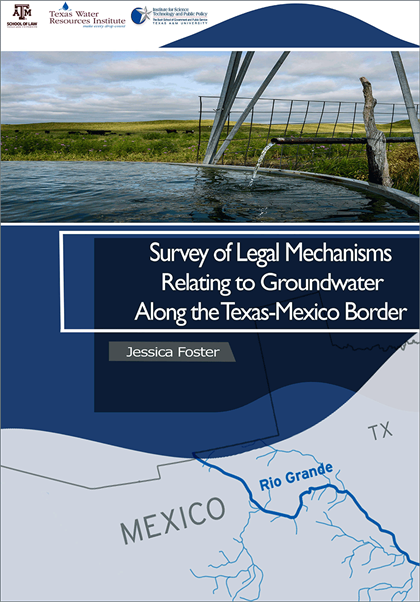SURVEY OF LEGAL MECHANISMS RELATING TO GROUNDWATER ALONG THE TEXAS-MEXICO BORDER
Author: Jessica Foster ’16 (J.D., Texas A&M University School of Law)
Sponsoring Institutions:
 Across Mexico’s border with Texas in the United States lie numerous aquifers on which both countries rely. Yet, there is no international agreement or formal basis for cooperation for using groundwater from these underground resources. Users on both sides of the boundary often withdraw groundwater without monitoring rate of extraction, knowledge of the available reserve or natural and artificial recharge rates, or constraints designed to protect groundwater quality. Moreover, the two nations apply disparate rules and regulations, at the federal, state, and local levels, to their respective portions of the aquifers for both quantity and quality issues. As a result, aquifers on both sides of the international boundary are susceptible to over-withdrawal and contamination, as well as other risks that users of shared subsurface water resources often face when they operate independently.
Across Mexico’s border with Texas in the United States lie numerous aquifers on which both countries rely. Yet, there is no international agreement or formal basis for cooperation for using groundwater from these underground resources. Users on both sides of the boundary often withdraw groundwater without monitoring rate of extraction, knowledge of the available reserve or natural and artificial recharge rates, or constraints designed to protect groundwater quality. Moreover, the two nations apply disparate rules and regulations, at the federal, state, and local levels, to their respective portions of the aquifers for both quantity and quality issues. As a result, aquifers on both sides of the international boundary are susceptible to over-withdrawal and contamination, as well as other risks that users of shared subsurface water resources often face when they operate independently.
The purpose of this project is to present a factual picture of the multiple groundwater governance frameworks that cover the same transboundary aquifers on the Texas-Mexico border. It examines, catalogs, and compares the various approaches that communities along the Texas–Mexico border take toward managing and allocating groundwater resources. It also presents a comprehensive survey of the existing rules, regulations, practices, and guidelines – from the federal, to the state, to the local level – that users and institutions on both sides employ to govern ground water usage within their various jurisdictions. The goal of this study is to lay a foundation for additional research and even coordination across the frontier in an effort both to improve knowledge and information about groundwater on the Texas-Mexico border, as well as to ensure that these critical resources are governed and managed in a manner that ensures their availability into the future.
- To download the report, please click here or on the report image.